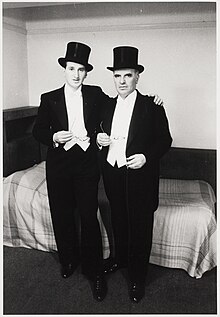Erich Salomon

Erich Salomon (28 April 1886 – 7 July 1944) was a German Jewish news photographer known for his pictures in the diplomatic and legal professions and the innovative methods he used to acquire them.[1]

- HIER WOHNTE
- DR. ERICH SALOMON
- JG. 1886
- FLUCHT HOLLAND
- DEPORTIERT 1944
- THERESIENSTADT
- AUSCHWITZ
- ERMORDET 7.7.1944
Life and work
[edit]Born in Berlin, as the son of the wealthy Jewish banker and Royal Councillor of Commerce Emil Salomon (1844–1909) and Therese Salomon née Schüler (1857–1915). The upper-class Berlin family lived at Jägerstraße 29 and later at Tiergartenstraße 15 (today the State Representation of Baden-Württemberg is located here). Salomon studied law, engineering, and zoology up to World War I. He served on the Western Front and was captured by the French in 1914. After the war, he worked in the promotion department of the Ullstein publishing empire designing their billboard advertisements. He first picked up a camera in 1927, when he was 41, to document some legal disputes and soon after hid an Ermanox camera usable in dim light in his bowler hat. By cutting a hole in the hat for the lens, Salomon snapped a photo of a police killer on trial in a Berlin criminal court.[2]
Beginning in 1928, Salomon worked for Ullstein's Berliner Illustrirte Zeitung as a photographer. With his multilingual ability and clever concealment, his reputation soared among the people of Europe. When the Kellogg-Briand Pact was signed in 1928, Salomon walked into the signing room and took the vacant seat of the Polish delegate, and took several photos.[3]
Salomon photographed the passage to Ellis Island, the route between Manhattan was frequently traveled by migrants in exile as Ellis Island at the time was a detention and immigration centre.[4] Salomon is one of only two known persons to have photographed a session of the U.S. Supreme Court.[5]
After Adolf Hitler came to power in Nazi Germany, Salomon fled to the Netherlands with his wife and continued his photographic career in The Hague. Salomon declined an invitation from Life magazine to move to the United States. He and his family were trapped in the Low Countries after Germany invaded in 1940. Salomon and his family were held in the Westerbork transit camp, then for almost five months in Theresienstadt concentration camp and were deported from there to the Theresienstadt family camp in May 1944. He and his wife were murdered in Auschwitz on 7 July 1944.[6]
The Dr. Erich Salomon Award is a lifetime achievement award for photojournalists given by the German society for photography.
In 1978 Salomon was inducted into the International Photography Hall of Fame and Museum.[7]
Photos by Salomon
[edit]- Summit Conference (1928; depicts foreign ministers of France, Germany, Britain, Poland, Japan, and Italy just before they signed the Kellogg-Briand Pact)[8]
-
Kellogg–Briand Pact (1928)
-
Hague Reparation Conference (1930)
-
Marlene Dietrich (1930)
-
Aristide Briand (1931)
-
Wedding of Juliana of the Netherlands (1937)
-
U.S. Supreme Court (1937)
References
[edit]- ^ "Erich Salomon". International Center of Photography. 2 March 2016. Retrieved 17 September 2018.
- ^ Green, David B. (28 April 2013). "This Day in Jewish History 1886: The First Photojournalist Is Born". Haaretz. Retrieved 17 September 2018.
- ^ "Farewell Appearance". Time. 7 June 1937. Archived from the original on 24 July 2010. Retrieved 10 August 2008.
- ^ Burcu Dogramaci; Helene Roth; Laura Karp Lugo; Mareike Hetschold; Rachel Lee, eds. (2020). Arrival Cities: Migrating Artists and New Metropolitan Topographies in the 20th Century. Leuven University Press. p. 17. ISBN 9789462702264.
- ^ "Farewell Appearance". Time. 7 June 1937. Archived from the original on 24 July 2010. Retrieved 10 August 2008.
- ^ "Erich Salomon". International Center of Photography. 2 March 2016. Retrieved 17 September 2018.
- ^ "Erich Salomon". International Photography Hall of Fame. Retrieved 25 July 2022.
- ^ "How A Single Image Started Political Photography". 100 Photographs | The Most Influential Images of All Time. Archived from the original on 3 June 2021. Retrieved 17 September 2018.
External links
[edit]- Erich Salomon, photographer – biography by Peter Hunter (Salomon) Archived 1 November 2019 at the Wayback Machine
- Photo Gallery Archived 12 March 2012 at the Wayback Machine
- the Ermanox (the camera Erich Salomon used)
Further reading
[edit]- Helmut Gernsheim. "Dr Erich Salomon 1886–1944: Historian with a Camera". Creative Camera. January 1972. Repr. in: David Brittain, ed. Creative Camera: 30 Years of Writing, Critical Image. Manchester: Manchester University, 1999, ISBN 9780719058042. pp. 46–52.
- 1886 births
- 1944 deaths
- German photojournalists
- German portrait photographers
- Westerbork transit camp survivors
- German people who died in Auschwitz concentration camp
- Theresienstadt Ghetto prisoners
- Photographers from Berlin
- Jewish emigrants from Nazi Germany to the Netherlands
- German Jews who died in the Holocaust






